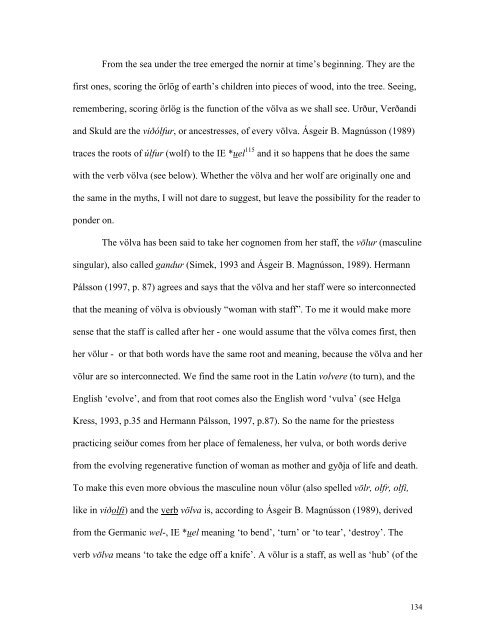Create successful ePaper yourself
Turn your PDF publications into a flip-book with our unique Google optimized e-Paper software.
From the sea under the tree emerged the nornir at time’s beginning. <strong>The</strong>y are the<br />
first ones, scoring the örlög <strong>of</strong> earth’s children into pieces <strong>of</strong> wood, into the tree. Seeing,<br />
remembering, scoring örlög is the function <strong>of</strong> the völva as we shall see. Urður, Verð<strong>and</strong>i<br />
<strong>and</strong> Skuld are the viðólfur, or ancestresses, <strong>of</strong> every völva. Ásgeir B. Magnússon (1989)<br />
traces the roots <strong>of</strong> úlfur (wolf) to the IE *uel 115 <strong>and</strong> it so happens that he does the same<br />
with the verb völva (see below). Whether the völva <strong>and</strong> her wolf are originally one <strong>and</strong><br />
the same in the myths, I will not dare to suggest, but leave the possibility for the reader to<br />
ponder on.<br />
<strong>The</strong> völva has been said to take her cognomen from her staff, the völur (masculine<br />
singular), also called g<strong>and</strong>ur (Simek, 1993 <strong>and</strong> Ásgeir B. Magnússon, 1989). Hermann<br />
Pálsson (1997, p. 87) agrees <strong>and</strong> says that the völva <strong>and</strong> her staff were so interconnected<br />
that the meaning <strong>of</strong> völva is obviously “woman with staff”. To me it would make more<br />
sense that the staff is called after her - one would assume that the völva comes first, then<br />
her völur - or that both words have the same root <strong>and</strong> meaning, because the völva <strong>and</strong> her<br />
völur are so interconnected. We find the same root in the Latin volvere (to turn), <strong>and</strong> the<br />
English ‘evolve’, <strong>and</strong> from that root comes also the English word ‘vulva’ (see Helga<br />
Kress, 1993, p.35 <strong>and</strong> Hermann Pálsson, 1997, p.87). So the name for the priestess<br />
practicing seiður comes from her place <strong>of</strong> femaleness, her vulva, or both words derive<br />
from the evolving regenerative function <strong>of</strong> woman as mother <strong>and</strong> gyðja <strong>of</strong> life <strong>and</strong> death.<br />
To make this even more obvious the masculine noun völur (also spelled völr, olfr, olfi,<br />
like in viðolfi) <strong>and</strong> the verb völva is, according to Ásgeir B. Magnússon (1989), derived<br />
from the Germanic wel-, IE *uel meaning ‘to bend’, ‘turn’ or ‘to tear’, ‘destroy’. <strong>The</strong><br />
verb völva means ‘to take the edge <strong>of</strong>f a knife’. A völur is a staff, as well as ‘hub’ (<strong>of</strong> the<br />
134


